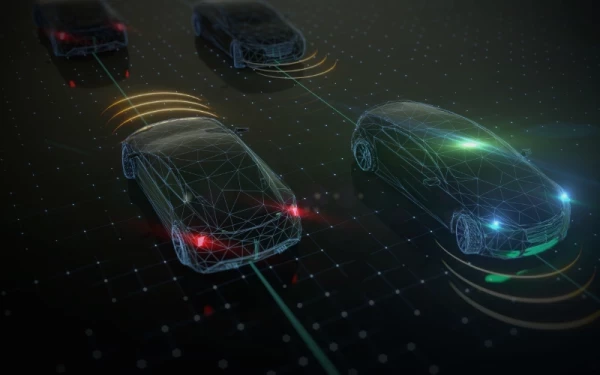Smart Vehicle Intervention Systems: Benefits, Challenges & Future Trends
Aug 18, 2025 Resolute Dynamics
Smart vehicle intervention systems (SVIS) are advanced safety technologies that monitor, analyze, and take action to prevent accidents before they happen. These systems use a mix of artificial intelligence (AI), telematics, and real-time control to keep drivers, passengers, and road users safe. They are already changing how fleets operate—and in the future, they’ll be at the heart of every smart transportation network.
What Are Smart Vehicle Intervention Systems?
Smart vehicle intervention systems are safety tools built into modern vehicles that don’t just alert drivers to danger—they step in and act. They can apply brakes automatically, correct the steering, or control speed when a risk is detected. These systems use sensors, cameras, and data analytics to understand what’s happening around the vehicle in real-time.
Today, these technologies are critical for fleet safety and compliance. They’re already being used in buses, delivery trucks, taxis, and rideshare vehicles to prevent crashes, protect assets, and lower insurance costs.
Core Components of SVIS
AI-Powered Vision and Perception

At the heart of SVIS is computer vision. Cameras around the vehicle constantly scan the environment—watching for lane markings, pedestrians, other vehicles, and traffic signs. Using machine learning, these vision systems detect dangerous behaviors like driver drowsiness, distraction, or tailgating.
This is more than just recording. The system interprets what it sees. For example, if a driver is looking away from the road for too long or is about to run a red light, it triggers an intervention.
Some systems also use infrared to improve performance at night or in bad weather.
Real-Time Telematics and Data Connectivity
Telematics is the brain of the system. It collects and transmits data—like speed, braking patterns, and GPS location—to a central platform. With AI analytics, this data becomes actionable insights.
Fleet managers can monitor driver behavior across vehicles, detect patterns of risky driving, and make real-time decisions to reroute or restrict a vehicle. Telematics also helps with predictive maintenance, which means fixing problems before they cause breakdowns.
This connected ecosystem is crucial in large cities and regions with poor road conditions, where immediate data-driven decisions save time, money, and lives.
Intelligent Control and Automated Interventions
When a risk is detected, the system doesn’t wait for a human to act. Intelligent control kicks in. It can reduce the vehicle’s speed, apply emergency braking, or send haptic feedback to the driver’s seat or steering wheel.
In electric and fuel vehicles alike, it can also optimize engine performance or lock acceleration under certain conditions, like school zones or accident-prone intersections.
These actions are automated, but not random—they’re based on real-time inputs from both inside and outside the vehicle.
Current Applications in the Field
In countries like India, Saudi Arabia, and the UAE, SVIS are used in public transport fleets to reduce fatal crashes. Fleet operators working in both dense cities and long-haul highway routes need adaptive systems that work in mixed driving conditions.
Logistics firms, school bus fleets, and urban ride-hailing services now use these systems to meet government safety rules, reduce liability, and improve driver training.
SVIS also support compliance with local transportation authorities who now require digital records and proof of safety interventions for insurance and legal purposes.
Benefits of Smart Intervention Systems
-
Crash Prevention: SVIS significantly reduce rear-end collisions, lane-drift crashes, and pedestrian strikes.
-
Lower Operational Costs: Fewer accidents mean fewer repair costs and downtime.
-
Better Insurance Rates: Many insurers offer lower premiums for vehicles equipped with active safety systems.
-
Improved Fleet Reputation: Safer fleets attract better drivers and more clients.
These benefits are especially important for commercial fleets where one serious crash can damage a company’s image and finances.
Challenges and Limitations of Smart Vehicle Intervention Systems
Smart vehicle intervention systems are making roads safer, but like any technology, they’re not perfect. These systems face real-world challenges that can affect performance, reliability, and user trust. Understanding these limitations is crucial for fleet operators, policymakers, and engineers working to build safer mobility networks.
1. Sensor Reliability in Harsh Conditions
Most smart intervention systems rely on a combination of cameras, radar, ultrasonic sensors, and LiDAR to detect surroundings. But bad weather can throw these systems off.
-
Heavy rain, snow, and fog can blur camera vision and block LiDAR pulses, making it hard to detect lanes, vehicles, or pedestrians.
-
Dust, mud, or bugs on camera lenses and sensor covers can block input entirely.
-
Poorly marked roads or faded lane lines reduce the accuracy of lane departure warnings and steering corrections.
This is known as environmental sensor degradation—and it’s one of the biggest limitations in advanced driver-assistance systems (ADAS). Without clear inputs, even the most powerful AI can make the wrong decision.
2. Frequent Sensor Calibration Needs
Precision sensors need regular calibration to stay accurate. This is especially true after minor collisions, windshield replacements, or suspension work.
-
Improperly calibrated systems may misjudge distances or fail to trigger safety responses.
-
Calibration often requires special equipment, trained technicians, and time-consuming alignment procedures.
For fleet managers operating in remote or under-resourced regions, this becomes a major logistical burden. Missed calibrations can lead to false alerts—or worse, missed interventions.
3. Connectivity and Infrastructure Gaps
Many SVIS platforms depend on real-time data transmission, using cellular or satellite connections to send location, speed, and event data to the cloud.
-
In areas with poor 4G/5G coverage, like rural highways or mountainous zones, systems may lag or fail to sync.
-
Lack of smart traffic infrastructure—like connected traffic signals or V2X-capable roadways—limits the full potential of vehicle-to-everything communication.
These infrastructure gaps slow adoption in many developing countries, where road safety improvements are needed the most.
4. Data Privacy and Ownership Concerns
Smart vehicles are essentially data hubs on wheels, constantly gathering and transmitting information:
-
Driver behavior
-
Location history
-
Passenger activity (in some ride-share fleets)
This raises major questions around data privacy and ownership:
-
Who owns the data—the fleet operator, the driver, or the software provider?
-
How is this data stored and protected?
-
Can it be used in legal disputes, insurance claims, or by third parties?
With strict regulations like the GDPR in Europe and CCPA in California, companies must build compliant, transparent data policies into their telematics and AI systems. Failing to do so can result in lawsuits, fines, or loss of user trust.
5. Edge Case Limitations in AI Decision-Making
While AI systems are improving fast, they still struggle with what engineers call “edge cases“—unusual or unpredictable scenarios, such as:
-
A pedestrian running across a highway at night
-
Animals on the road
-
Construction zones with unexpected lane shifts
-
Emergency vehicle interactions
These complex situations often require human-level reasoning and moral judgment, which today’s AI cannot fully replicate.
Until AI learns to handle these rare cases with confidence, human drivers will still need to be alert—even in highly automated vehicles.
6. High Upfront Costs for Smaller Fleets
Although smart intervention systems save money over time, the initial investment can be steep:
-
Hardware (cameras, radar, control modules)
-
Installation and calibration
-
Cloud subscription and data fees
-
Training for drivers and fleet managers
For small or independent fleet owners, especially in emerging markets, these costs can be a major barrier. Without subsidies or incentive programs, adoption remains slow in many areas that need it most.
Future Outlook and Innovations

The next generation of SVIS will be smarter, faster, and more independent. Here’s what’s coming:
-
Generative AI will predict not just what’s happening now, but what might happen in the next few seconds—like whether a pedestrian is likely to cross or if another driver will cut in.
-
V2X (Vehicle-to-Everything) systems will let cars talk to other vehicles, traffic lights, and even road signs.
-
Edge computing will allow decisions to be made inside the vehicle without waiting for cloud processing.
As global traffic regulations evolve, these systems will become mandatory—not optional.
How Resolute Dynamics Is Leading the Change
Resolute Dynamics is pushing boundaries in this space. Their platform combines vision (Capture), data intelligence (Connect), and real-time control (Control) into one powerful suite.
They work with fleets across MENA, India, and Southeast Asia to deliver real-world safety improvements. From real-time driver coaching to intelligent speed governance, their solutions don’t just collect data—they act on it.
Their tech is already saving lives and setting a new standard for proactive road safety.
Final Thoughts
Smart vehicle intervention systems are no longer futuristic—they’re here and working. They’re helping drivers make better choices, reducing crashes, and giving fleet operators the tools to take control of road safety.
In the future, these systems will become as standard as seatbelts. The journey ahead is not just about autonomy—it’s about intelligence, foresight, and intervention before disaster strikes.
Fleet managers, policymakers, and tech innovators have a rare chance to shape this future. And with the right systems in place, the road ahead can be a lot safer for everyone.
